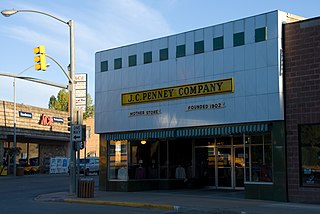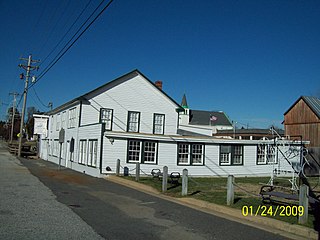
Kemmerer is the largest city in and the county seat of Lincoln County, Wyoming, United States. Its population was 2,415 at the 2020 census.

Penney OpCo LLC, doing business as JCPenney and often abbreviated JCP, is an American department store chain that operates 663 stores across 49 U.S. states and Puerto Rico. Departments inside JCPenney stores include Men's, Women's, Boys', Girls', Baby, Bedding, Home, Fine Jewelry, Shoes, Lingerie, JCPenney Salon, JCPenney Beauty, as well as leased departments such as Seattle's Best Coffee, US Vision optical centers, and Lifetouch portrait studios.

James Cash Penney Jr. was an American businessman and entrepreneur who founded the JCPenney stores in 1902.
The Wyoming Governor's Mansion is the official residence of the governor of Wyoming. The current mansion was built during 1976 in Cheyenne.

The J. C. Penney Historic District is a historic district in Kemmerer, Wyoming, encompassing several properties associated with James Cash Penney (1875-1971). The district includes the Golden Rule Store, the first in what became the J. C. Penney department store chain, and Penney's home during the store's early years. The district was declared a National Historic Landmark District in 1978, for Penney's role in creating one of the first national department store chains.

The A. C. Trumbo House is a house in Muskogee, Oklahoma, United States. It was built in 1906 for Arthur C. Trumbo as a replica of one of Mark Twain's houses and is on the National Register of Historic Places. The plot on which it stands was originally in the Creek Nation, Indian territory, before it was incorporated into Oklahoma on November 16, 1907.

J. C. Lore Oyster House, also known as J. C. Lore and Sons, Inc., Seafood Packing Plant, is located at 14430 Solomons Island Road South, in Solomons, Calvert County, Maryland. It is a large two story, rectangular frame industrial building constructed in 1934 as a seafood packing plant. It replaced a 1922 building that was destroyed by the 1933 Chesapeake Potomac hurricane. It is significant for its historical association with the commercial fisheries of Maryland's Patuxent River region, and architecturally as a substantially unaltered example of an early-20th century seafood packing plant. It has been adapted by the Calvert Marine Museum to house exhibits and many of its original spaces, artifacts, and records have been incorporated into them.

Menor's Ferry was a river ferry that crossed the Snake River near the present-day Moose, Wyoming, United States. The site was homesteaded by Bill Menor in 1892-94, choosing a location where the river flowed in a single channel, rather than the braided stream that characterizes its course in most of Jackson Hole. During the 1890s it was the only homestead west of the river. Menor's homestead included a five-room cabin, a barn, a store, sheds and an icehouse on 148 acres (60 ha), irrigated by a ditch from Cottonwood Creek and at times supplemented by water raised from the Snake River by a waterwheel. Menor operated the ferry until 1918, selling to Maude Noble, who continued operations until 1927, when a bridge was built at Moose.

The J. C. Penney Company Building located at 104 S. Rail Street in Shoshone, Idaho, is a historic department store building. It was built in 1918 by stonemason Ignacio Berriochoa.

The A.W. Patterson House is a historic house in Muskogee, Oklahoma. Located at the intersection of 14th Street and West Okmulgee, it is situated at the crest of a hill near the western edge of the downtown Muskogee neighborhood. It was built in 1906, before Oklahoma achieved statehood in 1907. It was listed on the National Register of Historic Places in 1984.

Wyoming Mercantile, also known as the Aladdin General Store is a preserved small-town general store in Aladdin, Wyoming. The store, which remains in operation, was built in 1896 by Amos Robinson as Wyoming Mercantile. Robinson died the same year, and the store went to Mahlon S. Kemmerer, who placed his properties, including the Wyoming and Missouri Valley Railroad, under the Wyoming Mercantile umbrella. Railroading continued until 1927. The store has continued, serving as a post office, bar, freight station and gas station.

The J. C. Penney Store in Anchorage, Alaska is a department store and part of the United States retail chain J. C. Penney. The store was established in 1962 on Fifth Avenue in downtown Anchorage, making J. C. Penney one of the first national retailers to establish a presence in the state following Alaska's admission to the union as the 49th state in 1959. The store has been housed in two buildings on the same Fifth Avenue site since it opened.

The Haddenham Cabin, located in Fossil Butte National Monument near Kemmerer, Wyoming, is a historic cabin that is listed on the National Register of Historic Places (NRHP).
The Kemmerer Hotel in Kemmerer, Wyoming was a hotel having historic status—it was added to the National Register of Historic Places—which was nonetheless demolished in 2003. The hotel remained on the National Register until 2013, when it was delisted.
James M. McDonald was an American retailing executive. He helped to build the JCPenney department store chain, as well as a chain of department stores under his own name.
Constance Anne Kemmerer, commonly known as Connie Kemmerer, is an American businesswoman and philanthropist. Kemmerer serves as a co-owner of the Jackson Hole Mountain Resort in Teton Village, Wyoming in the Jackson Hole valley. She has jointly owned the resort with her siblings, Jay and Betty, since 1992. Their family connection to Wyoming dates to the late nineteenth century when their great-grandfather, Mahlon Kemmerer, financed the founding of the Kemmerer Coal Company. Kemmerer, Wyoming, which started as a company town for Kemmerer Coal Company, is home to the first J. C. Penney store.

John L. "Jay" Kemmerer III, known as Jay Kemmerer, is an American businessman, entrepreneur, and philanthropist. He acquired the Jackson Hole Mountain Resort in Teton Village, Wyoming for his family in 1992, and served as Chairman until February 2024. In 1997, he acquired the CM Ranch in Dubois, Wyoming. His family connections to the State of Wyoming stem from the mining interests of his great-grandfather Mahlon S. Kemmerer in the 1890s, for whom the city of Kemmerer, Wyoming was named.

Hale Brothers Department Store, was a department store headquartered in Sacramento, California, with branches throughout the San Francisco Bay Area.
The CM Ranch and Simpson Lake Cabins are separate components of a single historic district associated with Charles Cornell Moore, a Fremont County, Wyoming dude ranch operator. The CM ranch, named after Moore, operated as a dude ranch from 1920 to 1942 and resumed operating in 1945. The Simpson Lake Cabins were purchased by Moore in 1931 and were operated as a hunting camp, continuing until 1997 when the CM ranch was sold to new owners and the Simpson Lake property was taken over by the U.S. Forest Service.. The sites are separated by 13 miles (21 km).

The T. M. Callahan House, also known as the ‘’’Sweeny-Callahan House’’’, at 312 Terry St. in Longmont, Colorado, is a large Queen Anne-style house built in 1892 and expanded in 1897 and 1908. It was listed on the National Register of Historic Places in 1985.

















